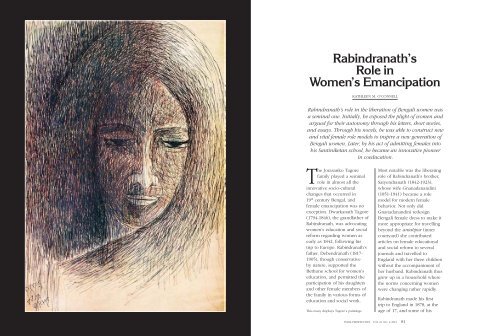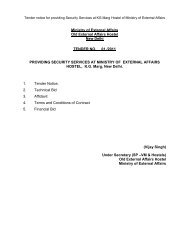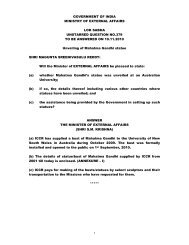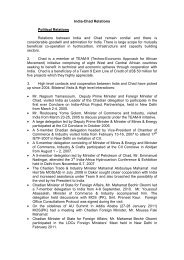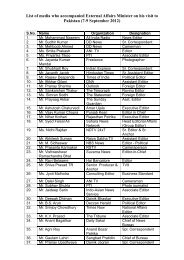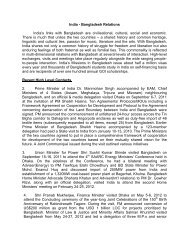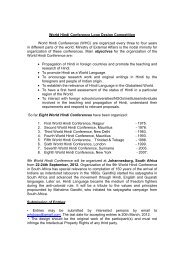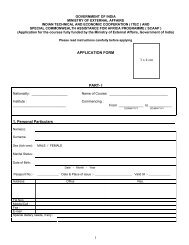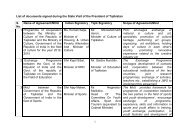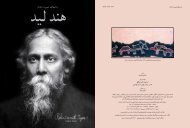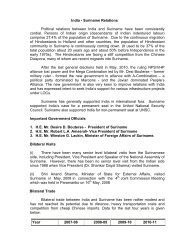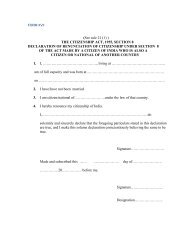Rabindranath’sRole inWomen’s EmancipationKATHLEEN M. O’CONNELLRabindranath’s role in the liberation <strong>of</strong> Bengali women wasa seminal one. Initially, he exposed the plight <strong>of</strong> women andargued for their autonomy through his letters, short stories,and essays. Through his novels, he was able to construct newand vital female role models to inspire a new generation <strong>of</strong>Bengali women. Later, by his act <strong>of</strong> admitting females intohis Santiniketan school, he became an innovative pioneerin coeducation.The Jorasanko <strong>Tagore</strong>family played a seminalrole in almost all theinnovative socio-culturalchanges that occurred in19 th century Bengal, andfemale emancipation was noexception. Dwarkanath <strong>Tagore</strong>(1794-1846), the grandfather <strong>of</strong>Rabindranath, was advocatingwomen’s education and socialreform regarding women asearly as 1842, following histrip to Europe. Rabindranath’sfather, Debendranath (1817-1905), though conservativeby nature, supported theBethune school for women’seducation, and permitted theparticipation <strong>of</strong> his daughtersand other female members <strong>of</strong>the family in various forms <strong>of</strong>education and social work.This essay displays <strong>Tagore</strong>’s paintingsMost notable was the liberatingrole <strong>of</strong> Rabindranath’s brother,Satyendranath (1842-1923),whose wife Gnanadanandini(1851-1941) became a rolemodel for modern femalebehavior. Not only didGnanadanandini redesignBengali female dress to make itmore appropriate for travellingbeyond the antahpur (innercourtyard) she contributedarticles on female educationaland social reform to severaljournals and travelled toEngland with her three childrenwithout the accompaniment <strong>of</strong>her husband. Rabindranath thusgrew up in a household wherethe norms concerning womenwere changing rather rapidly.Rabindranath made his firsttrip to England in 1878, at theage <strong>of</strong> 17, and some <strong>of</strong> hisINDIA PERSPECTIVES VOL 24 NO. 2/2010 81
earliest statements regardingthe need for Bengali women’sindependence come in a series<strong>of</strong> letters written to his family.After attending a party whereBritish men and women mixedfreely, <strong>Tagore</strong> wrote a lettercontrasting the free mixing thatoccurred between men andwomen in England and theisolation <strong>of</strong> Bengali women,who were confined to purdahand separated from the outsideworld. Wrote Rabindranath:It is only natural that men andwomen should seek amusementtogether. Women are a part <strong>of</strong> thehuman race and God has createdthem as part <strong>of</strong> society. To considerthe enjoyment <strong>of</strong> free mixingbetween people to be a cardinalsin, to be unsociable and to turnit into a sensational matter is notonly abnormal, it is unsocial, andtherefore in a sense uncivilized.Men are engrossed in all manner<strong>of</strong> amusement in the outsideworld, while women are like theirprivately owned tamed animals,chained docilely to the walls <strong>of</strong> theinnermost chambers <strong>of</strong> the houses.(Rabindranath <strong>Tagore</strong>, Letters froma Sojourner in Europe, ed. SupriyaRoy, Visva-Bharati, 2008: 88).In response to criticism <strong>of</strong>this letter, which had beenpublished in Bharati, thenedited by his older brotherDwijendranath (1840-1926), hewrote:The Editor has said that keepingwomen in purdah is not anoutcome <strong>of</strong> the selfishness <strong>of</strong>men, it is but a natural outcome<strong>of</strong> the demands that the duties <strong>of</strong>householding place on one. Thisis a very old excuse providedby those against liberation <strong>of</strong>women; but I feel that it need notbe pointed out that to considerthe practice normal to enter intopurdah, surrounded by walls forthe rest <strong>of</strong> one’s lifetime, severingall contacts with the rest <strong>of</strong> theworld, is in itself very abnormal(ibid, p.100).Following his return to India,<strong>Tagore</strong> was put in charge<strong>of</strong> the family estates in EastBengal. There, for the first time,Rabindranath had an extendedexposure to rural society andto the sufferings <strong>of</strong> rural peoplein general and rural women inparticular. This was the periodwhen many <strong>of</strong> his short storieswere written and we find himportraying the plight <strong>of</strong> orphansand widows such as Ratan inthe ‘Postmaster’ and Kusum in‘Ghater Katha’ (‘The Tale <strong>of</strong>the Ghat’) or the abuses <strong>of</strong> thedowry system and child-wivesas illustrated by the abuse <strong>of</strong>Nirupama in ‘Dena Paona’(‘Pr<strong>of</strong>it and Loss’), as well as therepression <strong>of</strong> female learningportrayed through the character<strong>of</strong> Uma in Khata (‘ExerciseBook’). Rabindranath’s mostradical short story ‘Strirpatra’(‘A Wife’s Letter’) came later.Here the transformation <strong>of</strong> itsmain female character Mrinal– an upper caste woman – isportrayed, from submissivewife to autonomous individual.Mrinal chooses to live apartfrom the joint family as aresult <strong>of</strong> the oppressivenessto a female relative that shewitnessed within the family.It should be noted thatRabindranath also encouragedfemale writers, and as a result<strong>of</strong> his encouragement, thefeminist writings <strong>of</strong> Sarat KumariChaudhurani (1861-1920) werepublished in such journals asSadhana and Bharati.When Rabindranath started hisschool in Santinketan in 1901,he had wanted to include girlsas well, but it did not provepractical until 1909, when afurther blow to the traditionalimage <strong>of</strong> the Brahmacharyashramoccurred with the admission <strong>of</strong>women. 1 The first six girls – who1 Both P.K. Mukhopadhyay and HimangshuMukherjee put the opening <strong>of</strong> the girl’s schoolin 1908, but Amita Sen, who lived in the ashramduring this period, gives it as 1909.had close associations with theashram – were boarded in one<strong>of</strong> the cottages, where they werelooked after by Ajit Chakravarti’smother and Mohit Chandra Sen’swife Susheela. What made theexperiment so radical was thatthe girls were not put in separateclasses but rather joined the boysin classes, sports and mandirservices. Further impetus for thewomen’s program came whenRathindranath was married tothe talented Pratima Devi (1863-1969) in 1910, and she begantaking a prominent role in theashram activities, particularly indrama and the arts.Rabindranath continued hisexploration <strong>of</strong> the femalepsyche in his writings. Thepublication <strong>of</strong> his novelGora was significant for itsdelineation <strong>of</strong> young femalecharacters and the manner inwhich they interacted withthe society around them. Suchcharacters as Lolita, Sucharitaand Anandamayee are shownin the process <strong>of</strong> shapingnew identities and personalautonomy as they developedalternate ways <strong>of</strong> interactionwith men and society. Thedevelopment <strong>of</strong> such vitalcharacters signalled theINDIA PERSPECTIVES VOL 24 NO. 2/2010 82 INDIA PERSPECTIVES VOL 24 NO. 2/2010 83


